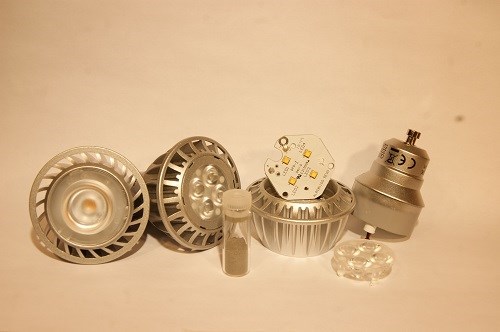Carbodeon Granted U.S. Patent for Nanodiamond-Containing Plastics
With thermally conductive plastics rapidly growing in demand, the addition of nanodiamonds to the arsenal of thermally-conductive fillers is only welcome.

Finland’s Carbodeon has been granted a U.S. patent for its technology which enables detonation-synthesized diamond particles –nanodiamonds (ND)—to be combined with polymers for use in fields such as consumer electronics, LED lighting, automotive and machine tools. The earth’s hardest natural mineral is also one of the most thermally conductive materials known, so when NDs are mixed in with thermoplastics in controlled amounts, they can enable plastics to conduct heat at pre-determined rates, and/or to be highly wear-resistant.
As we reported last year, the company is selling its ultra-dispersed” uDiamond ND fillers via U.S. representative SiliconSense of Nashua, N.H. Available in powder or liquid dispersions, the ND is reportedly fully dispersed into its primary particles without agglomeration. As such, the compounder and end-user can benefit from the entire available ND surface area, resulting in better performance with less material and cost.
ND-impregnated polymers can deliver heat-conducting benefits for products such as LED lighting, mobile devices including cellphones and Internet-of-Things (loT) enabled devices of any type. The hard wearing properties also make them ideally suited for use in the automotive and aerospace sectors to enable longer product life in hard-wear environments.
Carbodeon’s U.S. patent #9085723 is on the company’s developed nanodiamond containing thermoplastic thermally-conductive composites. The patent was filed after the company’s own developments during 2012-2013 whereby they discovered that the thermal conductivity of thermoplastics can be significantly enhanced by adding nanodiamonds, usually is relatively small quantities (e.g., 0.1%). Since filling the patent, Carbodeon has continued their own research as well as developing the range of commercial applications of the technology.
Said company CTO Vesa Myllmaki, “The granting of this patent represents a key part of our nanodiamond composite material portfolio. The combined coverage of our filed and granted patents will secure our position and that of our customers in several nanodiamond applications including polymers for thermal management applications, wear- and corrosion-resistant nanodiamond metal finishing, and wear-resistant/low-friction nanodiamond fluroropolymer coatings.”
A recently-released report, “Thermally Conductive Plastics Market by Raw Material, by End-Use Industry—Global Trends and Forecast to 2020”, by India’s market research firm Markets and Markets, projects a 14.3% annual growth of thermally conductive plastics over the 2015-2020 period. The report notes that thermally conductive plastics are used in a broad range of industries including electrical & electronics, automotive, industrial, healthcare, and aerospace. In 2015, the electrical & electronics segment accounted for the largest market share among all the end-use industries in terms of volume, followed by automotive, industrial, and healthcare. Among all the end-use industries, healthcare is estimated to grow at the highest annual rate.
Another interesting tidbit from this study is that rising demand from North America is the major driver for thermally conductive plastics. In 2015, North America is estimated to account for the largest market share in terms of volume, and is estimated to remain the market leader in the next five years. The use of shale gas as raw material for producing polymers has lowered the price of thermally conductive plastics and is boosting demand in this region. Within the last two years, the U.S. led the demand for thermally conductive plastics due to increased demand of LED lighting. Markets in emerging economies, such as Mexico, China, and India are projected to grow very rapidly.
Key companies profiled by this study are: BASF, Covestro, Saint Gobain, Toray Industries, DSM, Hella KGaA Hueck & Co., RTP Company, Celanese Corp., Polyone Corp., Kaneka Corp., and Mistubishi Engineering-Plastics.
Related Content
Compatibilizers Aid Recycling & Upcycling of Mixed Resins
Compatibilizers are proving their worth in boosting critical properties such as impact/stiffness balance of PCR and PIR blends of polyolefins and other plastics.
Read More3 Types of 3D Printed Tooling for Injection Molding
3D printed tooling for injection molding, including mold inserts, components and end of arm tooling, were on display at the Plastics Technology Expo.
Read MoreUnderstanding the ‘Science’ of Color
And as with all sciences, there are fundamentals that must be considered to do color right. Here’s a helpful start.
Read MoreGraphene-Enhanced Stretch Film Billed as 'World First'
Thinner, stronger films to be commercialized by Brazil’s Packseven in August.
Read MoreRead Next
Lead the Conversation, Change the Conversation
Coverage of single-use plastics can be both misleading and demoralizing. Here are 10 tips for changing the perception of the plastics industry at your company and in your community.
Read MoreTroubleshooting Screw and Barrel Wear in Extrusion
Extruder screws and barrels will wear over time. If you are seeing a reduction in specific rate and higher discharge temperatures, wear is the likely culprit.
Read More

















.png;maxWidth=300;quality=90)






